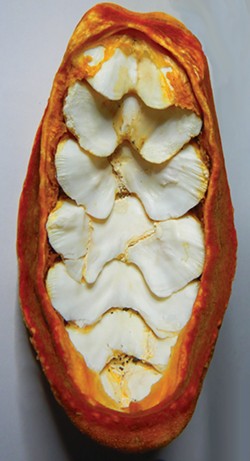[
{
"name": "Top Stories Video Pair",
"insertPoint": "7",
"component": "17087298",
"parentWrapperClass": "fdn-ads-inline-content-block",
"requiredCountToDisplay": "1"
}
]
Look there! It's Stiletto Stacy strutting down the street in her high heels knowing she looks sexier than the women wearing sensible shoes. And there goes Steel-toe Steve daydreaming about finding a hippie to kick the shit out of.
Isn't it interesting how a person's footwear is such an important part of their identity?
This got me thinking about the gumboot chiton (Cryptochiton stelleri) — chiton is pronounced "kite-un." What sort of footwear is a gumboot, anyway, and how does it inform us about the identity of this large marine mollusk?
Well, gumboot is an old name for rubber boots. And the internet thinks the chiton was named for looking like a gumboot. Maybe the original gumboots were reddish brown with a pebbly texture like the chiton's skin. Or maybe their sole was orange or yellow like the chiton's underside. But that's unlikely. And unless 19th century parents yelled, "Tally-ho, young'uns. Pull on your gumboots for a bully chiton expedition!" then gumboot chiton is just a bad name.
Some of today's cool young tidepoolers call gumboot chitons the "wandering meatloaf" because they resemble a meatloaf wandering in its shallow rocky habitat. It's a better name but they don't actually wander much. One gumboot chiton was measured wandering fewer than 20 meters in two years.
This meatloaf resemblance made me wonder whether the gumboot chiton's flesh is yummy like abalone and other mollusks. It turns out that the biologists who wrote the original Between Pacific Tides wondered, too. But the butchered flesh had such a strong smell that they gave up before cooking it.
Another common name is "giant western fiery chiton." This is appropriate because it's the world's largest chiton – growing up to 14 inches long and weighing almost 4.5 pounds. And some of them are almost fiery red, which supposedly depends on whether they eat a lot of red algae rather than brown or green algae.
Like other chitons, the gumboot has eight shell-like plates along its back. However, unlike other chitons, the plates are under the skin, so are not directly visible. The plates from dead chitons commonly wash up on the beach and are called "butterfly shells" due to their shape. The chitons themselves sometimes wash up after being knocked loose during big surf. (But they might be savable if placed back in a tide pool.)
The algae that these chitons graze on includes rock-encrusting species, so they need hard, sharp teeth. Like other mollusks, they have rows of teeth on their tongue-like radula. The gumboot chiton's teeth are tipped by the iron mineral magnetite, which makes the teeth magnetic and forms one of the hardest known biological materials.
While exposed at low tide, gumboot chitons often partially detach from the bottom in a posture that may help them respire. It's at this time you may see a worm living within the groove near the chiton's long gills. This worm — called Arctonoe — doesn't seem to bother the gumboot chiton. In fact, this worm has sharp jaws that it sometimes uses against potential chiton predators. For example, it's known to nip the tube feet off approaching sea stars.
Hey, there's Sandal Sam watching Stiletto Stacy through the hair blowing across his face. Uh-oh — Steel-toe Steve spots him. A bystander named Flip-flop Phillip sees and, like the Arctonoe worm, he decides to defend the victim from the enemy's feet. But then, characteristically, Flip-flop Phillip changes his mind.
Steel-toe Steve is too enthusiastic and kicks Sandal Sam to death. Later, Steel-toe Steve is sentenced to 40 years, which happens to be the longest reported lifespan of a gumboot chiton.
Biologist Mike Kelly (he/him) is also the author of the book Tigerfish: Traditional and Sport Fishing on the Niger River, Mali, West Africa. It's available at Amazon or everywhere e-books are sold.
Comments
Showing 1-1 of 1
more from the author
-
Hot Tomcod Action
- Apr 18, 2024
-
Sea Palm Crime
- Jan 11, 2024
-
Barnacle Envy
- Nov 16, 2023
- More »

































